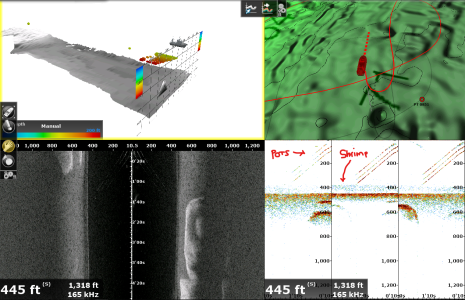PolarMarine
New member
This application is for extreme detail for the following:
shrimp are up to 25-30 cm
50-100 fm depth
sometimes on structure
This is at the limit for 200kHz at 1kW traditional sounder and the B259 with DFF1 has not been showing any of this stuff. The low frequencies are too large of a beam angle to do any good. The best so far has been a DFF3D with 165T-B54. It appears to work well because of the narrow fore-aft beam width. The wavelength for resolution of these targets suggests higher frequencies would be best.
It have heard that CW would work better for depth penetration compared with CHIRP. I don't know which one would work best for detail at this depth. Does it make more sense to go with an R109 with narrow 4-6 deg beamwidth on a DFF3 as CW, or use with TZT3 and DI-AMP as CHIRP?
Here's a screenshot of what they look like with the DFF3D. Any input appreciated.
shrimp are up to 25-30 cm
50-100 fm depth
sometimes on structure
This is at the limit for 200kHz at 1kW traditional sounder and the B259 with DFF1 has not been showing any of this stuff. The low frequencies are too large of a beam angle to do any good. The best so far has been a DFF3D with 165T-B54. It appears to work well because of the narrow fore-aft beam width. The wavelength for resolution of these targets suggests higher frequencies would be best.
It have heard that CW would work better for depth penetration compared with CHIRP. I don't know which one would work best for detail at this depth. Does it make more sense to go with an R109 with narrow 4-6 deg beamwidth on a DFF3 as CW, or use with TZT3 and DI-AMP as CHIRP?
Here's a screenshot of what they look like with the DFF3D. Any input appreciated.



